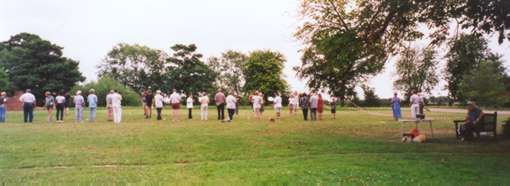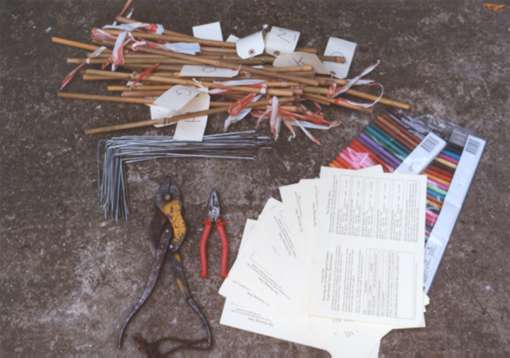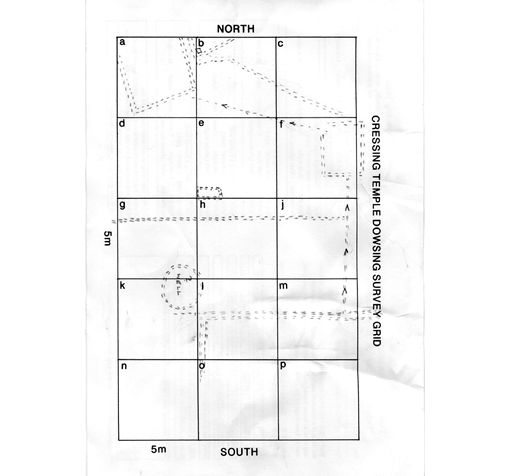Dowsing Archaeological Features;
An empirical study at Cressing Temple, Witham, Essex.
(TL799187).
26. Methodology.

41. Photograph of the participants during the Test Day. The
author is near centre in black shorts and T-shirt. This is the first exercise
looking for the water-main. (Eileen Crouch).
A large group of people (Figure. 41) were randomly attracted to take part in the tests and survey. There were two sessions, one at 10.30am and one at 2.00pm on Sunday the 25th of July both following exactly the same format as outlined below;
1. A talk was given by the author, introducing the aim of the project and an outline of the tests. None of the history of the site was divulged other than it became the property of the County Council in 1987.

42. Photograph of all the equipment used during the Test Day.
2. Those persons who had brought their own coathangers had rods made from them by the author to the same pattern as those that were supplied. (Figure. 42).

43. A copy of the questionnaire given out to the participants.
This is the one that Colin Peal returned. It is interesting to compare his
readings to those of his previous surveys.
3. A questionnaire was handed out along with coloured pens for its completion and the first section concerning the individuals themselves was filled in following advice. (Figure. 43).
4. The author gave a demonstration of how to hold the rods such that they could move freely without restriction or undue influence by the user. (Figure. 8).
5. The tests were carried out in the sequence laid down in the questionnaire and the participants encouraged to record their responses. Special attention was given to those who could not get any reaction and this was usually due to the way the rods were gripped. Others exchanged rods for heavier or lighter ones. Others found they could dowse with one hand only.
6. The survey grid was explained in relation to its orientation and labelling and the participants encouraged to record any reactions they experienced. No guidance or indication of possible features was given.
7. The questionnaires were gathered and a wind-down talk with vote of thanks to the participants was given. In the morning session the author did not reveal any of the archaeological detail that may have been discovered.
Head counting showed that exactly 70 people turned up for the tests of which 62 returned questionnaires, some may have mistakenly taken them as souvenirs, two others were children too small to understand the proceedings. All the tests were carried out within the confines of the centre of Cressing Temple as shown on the plan.
Photographs were taken by Eileen A Crouch and Gill Hillman and an hour long home video record of the first session was taken by Brian T Crouch.
Barry Hillman-Crouch. MSt PA, Dip FA, BSc, HND. Written 1999 Published on the web June 2005.